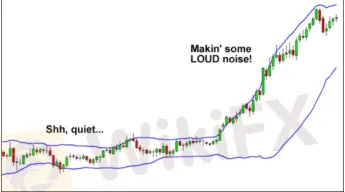xysoom: Learn how to use the Bollinger line to accurately
Learn how to use the Bollinger line to accurately
Bollinger Bands, the invention of John Bollinger, is used to measure a markets volatility and identify “overbought” or “oversold” conditions. This little tool tells us whether the market is quiet or loud. When market is quiet, the bands contract and when market is loud, the bands expend.To get more news about WikiFX, you can visit wikifx news official website.
It can be seen from picture that the Bollinger Bands is a chart that is displayed over the price. When the price is stable, the bands are close. When the price moves up, the bands spread apart. The upper and lower bands measure volatility, or the degree in the variation of prices over time. The volatility bands automatically adjust according to changing market conditions.

Most charting programs default to a 20-period, which is fine for most traders, but you can experiment with different moving average lengths after you get a little experience applying Bollinger Bands.
The concept of standard deviation (SD) is just a measure of how spread out numbers are. If the upper and lower bands are 1 standard deviation, this means that about 68% of price moves occurred recently are CONTAINED within these bands. If the upper and lower bands are 2 standard deviations, this means that about 95% of price moves occurred recently are CONTAINED within these bands.
As you can see, the higher the value of SD you use for the bands, the more prices the bands “capture”. You can try out different standard deviations for the bands once you become more familiar with how they work. Honestly, you don‘t need to know most of this stuff to get started. We think it’s more important that we show you some ways you can apply the Bollinger Bands to your trading.
If you said down, then you are correct! As you can see, the price settled back down towards the middle area of the bands.
What you just saw was a classic Bollinger Bounce. The reason these bounces occur is because the Bollinger bands act like dynamic support and resistance levels.
The longer the time frame you are in, the stronger these bands tend to be. Many traders have developed systems that thrive on these bounces and this strategy is best used when the market is ranging and there is no clear trend. You only want to trade this approach when prices are trendless. So be mindful of the WIDTH of the bands.
Avoid trading the Bollinger Bounce when the bands are expanding, because this usually means the price is not moving within a range but in a TREND! Instead, look for these conditions when the bands are stable or even contracting.
Bollinger Squeeze
The “Bollinger Squeeze” is pretty self-explanatory. When the bands squeeze together, it usually means that a breakout is getting ready to happen. If the candles start to break out above the TOP band, then the move will usually continue to go UP. If the candles start to break out below the BOTTOM band, then price will usually continue to go DOWN.
Looking at the chart above, you can see the bands squeezing together. The price has just started to break out of the top band. Based on this information, where do you think the price will go?
This is how a typical Bollinger Squeeze works. Setups like these don‘t occur every day, but you can probably spot them a few times a week if you are looking at a 15-minute chart. There are many other things you can do with Bollinger Bands, but these are the two most common strategies associated with them. Go ahead and add the indicator to your charts and watch how prices move with respect to the three bands. Once you’ve got the hang of it, try changing up some of the indicators parameters.







Add comment